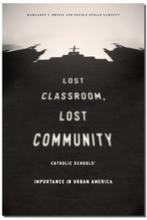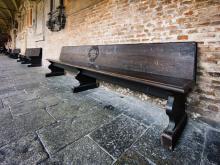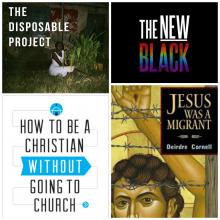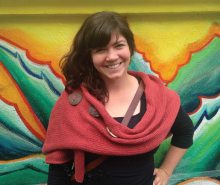Community

Yesterday morning at 5:30 I woke up to a disconcerting email:
Suspicious Sign-In Prevented. Please check your Google activity immediately.
In my half-asleep bleariness, I clicked the link and filled in my password.
Then I realized I'd been scammed.
"Recognize" was spelt "recognise" — and the account email was from Googlemail.com, not Google.com. Otherwise, the email was identical to those I'd gotten from Google in the past.
The next two hours were spent frantically re-securing my life. Changing passwords, adding two-step verification, application passwords.
I suddenly realized how much of my life was online. My Facebook page was a chronicle of my wedding, my jobs, my son's first 2 years of life.
Most people my age are the same way. Sometimes it's easier online.
The first people to find out about my pregnancy three years ago, besides my husband, were members of an online birth month group at WhattoExpect.com. Weeks before we told family or close friends, we shared intimate details about morning sickness, headaches, and faint lines on pregnancy tests.
Why do we do this? Somewhere, all of us, in Fantasy Football groups and pregnancy groups and dog lover groups and gluten-free groups: we're longing for Real Community.

Editor's Note: The following transcript is from a homily given in Christ Chapel at Gustavus Adolphus College in St. Peter, Minn. As part of the “From Segregation to Integration through Conversation” faith and learning series, the text for the day was 1 Corinthians 12:14-26.
The color of my skin is white. I am Caucasian. I am white, from head to toe, in case you had not noticed. It is quite possible that you had not noticed, because in case you have not noticed, most days in this place, most all of us have skin that is white. And as those of us that experience winters in Minnesota know better than most, in the midst of a “white out” it is difficult to notice anything that is not white.
While there are some special days with some special circumstances and some special exceptions, we in this place tend to be white people surrounded with other white people. Because the fact of the matter is that most white people in most places tend to have social circles that are mostly filled with other white people.
As was recently reported by the Public Religion Research Institute’s 2013 American Values survey, when respondents were asked to identity as many as seven people with whom they had discussed important matters in the six months prior to the survey, the results revealed just how segregated white social circles actually are. As reported by the study, the social circles of white people in the United States are 91 percent white. In addition, the analysis also showed that over 75 percent of white people reported exclusively white social circles, without any minority presence whatsoever.
All together, the Public Religion Research Institute showed the sociological fact that, even in an increasingly diverse multi-cultural nation, birds in the United States with white feathers — such as my own — continue to flock together. In other words, contrary to the common cliché often given in response to these difficult topics, when it comes to white American people, the facts reveal that "some of our best friends" simply are not black.

THE PROBLEM WITH Christianity today is not that Christians lack faith in God. The problem is that Christians believe they “know” and “understand” God completely. In a world overflowing with information, we hardly acknowledge the importance of God’s unknowability. Yet a conception of God that doesn’t recognize the unknowable keeps us in an uncritical banality, which in turn leads us to follow orders without questioning, to play it safe, and to go along with mass opinion.
For Christians, conversion is required. Theologian Bernard J. F. Lonergan defines conversion not simply as an acceptance of a new belief system, but rather as “a radical shift from an old horizon to a new horizon.” Religious conversion, in particular, is to “fall in love with God.” Thus, to convert is to deny the conventional, habitual belief and knowledge system, and to discover a new reality in which one becomes open and vulnerable to challenges. Conversion is not a solitary experience. It is a prolonged dialogue that constantly transforms one’s horizon and motivates us to wonder, appreciate, and raise more questions.
The texts for the next four weeks invite us to a conversion experience. They are reminders that conversion starts with abandoning any sense of security based on doctrines, dogmas, rituals, and systems of belief—precisely because God’s love never allows us to find comfort in human constructions.

Theology doesn’t save us from spiritual burnout — people do.
No matter how convincing our doctrines and beliefs may be, they’re ultimately empty and unsatisfying if there’s no human relationship personifying them.
Throughout our faith journeys we’ll be faced with moments of suffering, hopelessness, and sheer desperation — sometimes lasting for what seems like forever. We’ll want to give up — sometimes we will.
These hardships can devolve into isolation, bitterness, and ultimately transform what was once a healthy spirituality and turn it into a total rejection of God. Within Christian culture we label this as “burnout,” but in reality it’s more of a “falling out.”
Not only do we have a falling out with God, but we also disassociate ourselves from other believers and those closest to us. When we feel hurt, betrayed, or abandoned by people we assume God is to blame, causing us to doubt God’s love for us — even questioning God’s very existence.
Many quit faith not because of a newfound disbelief in God, but because of broken and unhealthy human relationships — people are the main reason we give up on God.

Diedrich Boenhoeffer wrote about it. Pastors preach about it. Churches strive for it.
Community.
It is a concept that has had a long history in the American church. It can come in many forms. Bringing a meal to a stressed out new mother. A church ice cream social. Youth group. Singles ministry.
But what does community look like when working on a social issue?
For human trafficking, that community comes in the form of partnerships. The 2000 federal Trafficking Victims Protection Act (TVPA) originally addressed human trafficking by creating the three 'Ps': prevention, protection, and prosecution. But after implementation occurred, the anti-trafficking community realized there was something missing. Thus, in 2008, the fourth 'P' —partnership — was added.

What happens to a community when a Roman Catholic school closes its doors?
That’s the question Nicole Stelle Garnett and Margaret F. Brinig, two Notre Dame law professors, pondered as they studied closures in Chicago, Philadelphia, and Los Angeles.
There were 7,000 Catholic schools in the U.S. in 2010, down from 13,000 in 1960, according to the National Catholic Education Association. The decline, rooted in the migration of parishioners to the suburbs and the secularization of Catholic culture, has been dubbed the “closure crisis” within the church.
Religion News Service asked Garnett about what she and Brinig found in their investigation, which resulted in their new book: Lost Classroom, Lost Community: Catholic Schools’ Importance in Urban America.
The interview has been edited for length and clarity.

Last year I spoke at a missional church conference in Southern California. The guy who spoke before me asked every one of these missional pastors do a simple exercise.
“Turn to the person sitting next to you,” he said, “and tell them the names of your neighbors on every side of your house (or apartment) and share one story about their lives.”
The room went abuzz.
After a few minutes the speaker called the audience back and asked: “How many of you could share the names and stories of each of your neighbors on every side of your house?” No one raised their hands.
The speaker asked how many could share the names and stories of a few of their neighbors. Only about three people in an audience of about 200 raised their hands. This was a missional conference.

It feels awkward and even a bit inappropriate to be talking about ‘celebrity news’ when so much is going on around the world: Iraq, refugees in Syria, children stranded at borders, Michael Brown’s death and Ferguson, Ebola, Ukraine, and the list tragically goes on.
But then again, it feels appropriate because it’s another reminder of the fragility of our humanity.
As has saturated the news, Robin Williams passed away this week. His life ended way too short at the young age of 63 – apparently because of suicide. While this was news to me, Robin had been struggling with intense depression – especially as of late — and was recently diagnosed with Parkinson's Disease.
To be honest, I don’t get caught up too much on celebrity happenings mainly because there’s not much genuine connection. I don’t really know them personally. Make sense? Robin Williams’ death – on the other hand – just felt like a painful punch in the gut. Perhaps, it’s because Mork and Mindy (Nano Nano) was the first TV show I watched (along with Buck Rodgers) after immigrating to the United States. I deeply resonated with Mork – this ‘alien’ or ‘foreigner’ from another land trying to fit in. Perhaps, it’s because so many of the characters he played in countless movies influenced me on some level as it did so many others.

"Living the Word" reflections for October 2014 can be found here.
ACROSS DENOMINATIONS, Christians have attempted to build a more egalitarian and democratic ecclesiastical structure. The phrase “discipleship of equals,” coined by the feminist theologian Elisabeth S. Fiorenza, suggests that a community of Jesus’ followers cannot tolerate an absolute, centralizing power that justifies a relationship of dominance and subordination.
Yet, while Christians continue to challenge hierarchical structures in the church, we also acknowledge that a discipleship of equals will not be established simply by removing the hierarchy. The church is enmeshed in a concrete reality of everyday life, filled with a web of power relations that are neither fixed nor necessarily top-down.
Power relations experienced within the church are often inconspicuous. They take the form of microaggressions, subtle insults against other members because of gender, sexual orientation, race, class, and ability status. What is even more hurtful is that these insults are often disguised as “caring,” as when someone perverts a prayer request into gossip. The experience of the powers in the church can be paradoxical. Christians must deal with complicated and variegated claims to power, all of which borrow the name of God.
The texts for the next four weeks highlight the struggles in forming a community of God. They raise the question of power relations within the faithful community: How do we use the word “power” and what should be our first instinct in situations of conflict?

A new model of leadership that’s been refined in the fires of change and conflict is emerging from U.S. religious women.
In June, the Institute for Policy Research and Catholic Studies, along with Solidarity with Sisters, invited 150 people to Catholic University for an opportunity to discuss the model of leadership that has developed in Catholic women’s communities around the world over the last 50 years since Vatican II. The event coincided with the release of Spiritual Leadership for Challenging Times, an anthology of 10 addresses given by Leadership Conference of Women Religious (LCWR) presidents.
Catholic sisters are emerging as leaders ahead of their times. From Sister Simone Campbell, SSS, and Nuns on the Bus to Catholic Health Association CEO Sister Carol Keehan, DC, who helped pass the Affordable Care Act, to former LCWR president Sister Pat Farrell, OSF, who practiced authentic spiritual leadership in the face of the Vatican’s ongoing investigation of that organization (an investigation that Pope Francis should have laid quietly to rest, but has not), religious women are getting notice for their thoughtful, faithful leadership in the face of withering criticism and their own communities’ dramatic changes.
What are the marks of this new leadership?
THE 67 PEOPLE gathered in the basement of Union Baptist Church in Memphis have come from all over: Appalachian State University and Asbury College, Louisiana State and Liberty University, Wright State and Wheaton College. The youngest is 21; the oldest, 48. They’ve come to teach in some of the lowest performing schools in the state of Tennessee.
For the next 12 months, they’ll live, learn, and pray together, becoming a family as they also learn to become teachers and colleagues. All were drawn by faith and a dream that God is doing unexpected things in the city schools of Memphis.
Welcome to the Memphis Teacher Residency (MTR), a faith-based nonprofit that’s become one of the most effective teacher training programs in Tennessee.
At the front of the room, Rev. Tom Fuerst, an associate pastor at Christ United Methodist Church, gives the morning devotional. His message: The world is broken and so are Memphis schools. But God wants to fix them both. Fuerst describes the idea of “prior grace”—that God is at work in the world long before we are aware of it—and invites the new trainees to become agents of that grace by becoming great teachers.
But Fuerst, like everyone at MTR, is quick to warn the aspiring teachers—known as residents—against proselytizing. The residents, as public school teachers, don’t preach faith in the classroom, hold Bible studies, or actively discuss their faith. That would make the classroom unsafe for non-Christian students, warned Fuerst.

THROUGH THEIR EYES
In 2011, Raul Guerrero provided 100 Kodak disposable cameras and taught basic photography skills to nine young students in the Newlands area of Moshi, Tanzania. The Disposable Project book brings together their images of their community, with text by Guerrero. the-disposable-project.com
JOURNEYING
“Migration has been, for centuries, not only a source of controversy but a source of blessing,” Deirdre Cornell writes in Jesus Was a Migrant. Inspired by ministering among immigrants in different settings, this is a beautifully written set of deeply humanizing reflections on the immigrant experience and Christian spirituality. Orbis Books
FAITH-ROOTED Organizing: Mobilizing the Church in Service to the World outlines a theological cartography of social change. In this critical intervention, Alexia Salvatierra and Peter Heltzel reimagine—and as a necessary consequence, rechart—the landscape of vision, action, and strategic planning needed for social change.
Full disclosure: I have attended several trainings conducted by the co-authors. Indeed, the dual authorship of the text is a principal strength. Faith-Rooted Organizing blends the voice of an evangelical-activist theologian in Heltzel with the homespun profundity of a seasoned pastor and campaign organizer in Salvatierra. The authors delight readers with complementary writing styles: Heltzel speaks through theological propositions, interpolated intermittently with jazz references and theological punch lines; Salvatierra communicates through proverbs, organizing anecdotes, poignant biblical passages, and narrative side notes.
The result is a well-argued and accessible text that should resonate from the seminary to the sanctuary. Their driving thesis is that faith communities, especially Christian ones, should organize for social change in a way that is rooted and guided by the stories, symbols, sayings, and scriptures of our faith. Faith-Rooted Organizing functions as an instruction manual on effective advocacy while providing a theological rationale and vocabulary for a vocation marked by tremendous victories and colossal failures, breakthrough partnerships and fragmented coalitions, glimpses of beloved community and portraits of democracy stillborn.

Bio:
Katerina Friesen is studying theology and peace studies at Anabaptist Mennonite Biblical Seminary in Elkhart, Ind.
1. How would you describe your current vocational role?
I see my role as both revaluing what has been cast down and degraded and building resilient communities. So far this has taken shape through land-based ministries of farming and community gardening, inviting people to work together and celebrate the sacramental in soil, food, and one another.
2. You spent several years with the Abundant Table Farm Project in Santa Paula, Calif. Can you describe the project and your role there?
The Abundant Table Farm Project is a working farm and young adult internship program that has evolved into a Christian community. I joined the project in 2009 and lived in community with four other women. My daily work of farming gave me a bodily understanding of farm workers’ labor and the need for justice and wholeness in our incredibly disconnected food system.

THERE ARE apparently 2,000 film festivals around the world, so the format of red carpet arrivals, gala screenings, and Q&A sessions that appear all but scripted in advance have become well and truly entrenched. The best festivals recognize that their purpose is to cast a spell over filmgoers and filmmakers alike, inviting them into a spacious place where the heart of the dream that led to the film being made and the audience’s reason for watching it can beat in a community of people who thirst for art that gives life. Unsurprisingly, the biggest festivals find it hardest to pull this off—asking for contemplative mutuality at Cannes or Sundance is like looking for a Buddhist tea garden at Disney World.
Yet film festivals can be places where small is indeed beautiful. It’s only the movies that need to be big—or at least their capacity to alchemize with the viewer’s autobiographical narrative. The trappings of VIP lounges, paparazzi, and celebrity gossip are just that: They trap the aesthetic air, creating distance between people and art. Smaller festivals may be more capable of nurturing something that really feels like community.
So when at North Carolina’s Full Frame Documentary Film Festival this spring we watched Visitors, Godfrey Reggio’s follow-up to his epochal Qatsi trilogy, and the diverse faces of human beings segued into natural landscape and a Louisiana cemetery, the sense of empathic connection with an artist who spent the first 14 years of his life in New Orleans and the next 14 as a Christian Brothers monk was palpable. The impossible-to-categorize musician Nick Cave portrayed a sly version of himself in the pseudo-documentary 20,000 Days on Earth, intercutting concert footage with a role-played therapy session, visits with friends, and a neo-noir road trip, to moving effect. And the gay rights courtroom drama of The Case Against 8 played to an audience of citizens whose state had adopted a constitutional amendment to ban same-sex marriage; the showing led to near-euphoric anticipation of how a better history can reverse this tide.

SINCE HIS ELECTION as the 265th successor of St. Peter, Pope Francis has provided a refresher course on Catholic social teaching to the world’s 1.2 billion Catholics. “Catholic social teaching is no longer a secret,” says Jean Hill, director of peace and justice for the diocese of Salt Lake City. “Everything Pope Francis is saying comes from social doctrine and is about social justice.”
Through his various homilies, speeches, and meetings, Francis is “reading the signs of the times” and making practical application to the issues of the day. Some of his most powerful statements to date were made in his first pastoral document, “The Joy of the Gospel,” including this declaration: “I prefer a church which is bruised, hurting, and dirty because it has been out on the streets, rather than a church that is unhealthy from being confined and from clinging to its own security.”
Pope Francis is calling the faithful to be more merciful, compassionate, joyful, and centered upon the needs of the poor and vulnerable. He wants a church that sees the human person before the law and one that does not “obsess” about a narrow set of issues, but affirms both human life and human dignity. He invites Catholics to pray, reflect, and embrace the beauty and breadth of Catholic social teaching—a rich tradition that is predicated on the dignity of the human person.
The United States Conference of Catholic Bishops (USCCB) defines Catholic social teaching as “a central and essential element of our faith. Its roots are in the Hebrew prophets who announced God’s special love for the poor and called God’s people to a covenant of love and justice.” This teaching is also founded on the life and words of Jesus. It posits that “every human being is created in the image of God and redeemed by Jesus Christ, and therefore is invaluable and worthy of respect as a member of the human family.”
RURAL COMMUNITIES in the U.S. wrestle with many of the same problems facing the rest of the country—persistent unemployment, access to quality health care, air and water degradation, a broken immigration policy. Other issues—such as supporting sustainable farming practices and drawing young people into agriculture, lack of broadband access, and the challenges of small-town economic development—are more unique to rural life.
Even though the 46.2 million people living in rural U.S. counties constitute only 15 percent of the country’s total population (spread across 72 percent of the nation’s land area), we are all connected—urban, suburban, and rural—by foodways, waterways, wilderness areas, and our national politics. As one Midwest-based organizer put it, “many progressives fundamentally don’t understand rural America—they don’t even know why they should care about it. You can’t understand the power of the tea party without understanding rural America. It is the key to the House of Representatives, and progressives will be hamstrung until they can make inroads in a few key congressional districts.”
But that organizer and others also draw power and hope from the deep history of populism in the rural Midwest and parts of the South, and the endurance of community-oriented values that aren’t just “heartland” clichés.
While many young people are itching to leave rural areas and small towns—anxious to find better jobs, educational opportunities, or city culture—others have always stayed put or returned after time away. And some “city cousins” move to rural America, enjoying the opportunity to work on issues they care about (with the bonus of a brilliant night sky). Here are four stories of young people investing in rural communities in the Midwest. —The Editors
“It makes a difference in the lives of people.”
Rae O’Leary, 29, is a respiratory therapist and nurse on the Cheyenne River Indian Reservation in north-central South Dakota. The reservation straddles two counties, the fourth- and 11th-poorest in the nation. O’Leary works for Missouri Breaks Industries Research Inc. in Eagle Butte, the reservation’s hub with a population of about 1,300. She lives 20 miles out, on a ranch with her husband and two young children. O’Leary is a member of the Turtle Mountain band of Chippewa; her husband is a member of the Cheyenne River Sioux Tribe, and their children are enrolled in that tribe.
“When I define how rural we are, I tell people our nearest Wal-Mart is two hours away. That’s my point of reference for city folk.

Did you see what happened in Louisiana over the weekend? A 26-year-old man was driving his pickup truck over a causeway on Lake Pontchartrain. His truck plunged over the railing and into the water.
What happened next is inspiring.

You can smile at someone, but you can’t really smile with someone until you’ve cried with them, too. Shared their pain, their doubts, their questions, their uncertainty, even their despair. And their joy as well, those moments when your eyes fill with tears for a different reason. You end up smiling together with tear-stained cheeks. And those smiles matter the most.

When our church receives new members, we share a covenant that includes the commitment to “journey together.” Often, we realize this can mean ‘journeying’ into unwanted, dark, difficult, or surprising places with each other. We have stood with each other as loved ones pass away. We stand with each other in the difficult role of being children of aging parents, or parents of growing children. We bear witness to the power of hope when someone we love struggles with depression. We celebrate commitments made, successes honored, and loves found. The Christian faith, we realize, is rarely about solutions; it is about the authentic and real journey of life and a common trust that our God walks with us, no matter what.
For a variety of reasons, a former bishop in another denomination found us in the immediate aftermath of a horrible car accident that resulted in the death of an innocent and lovely woman in a nearby community.
Rather than becoming a setting to explore the details of this accident, our congregation became a lifeline for him during the months he awaited his fate and eventual conviction of second-degree reckless homicide. Week in and week out, he attended worship, sang with us, prayed with us, and sought spiritual solace with us. His presence was quiet but consistent. He didn’t ask for special attention, indeed didn’t want to make us uncomfortable with his presence. As a person of faith on his own difficult journey, he simply wanted to be in worship with a community.